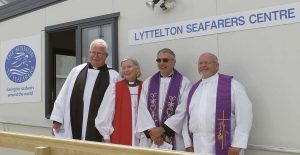by JENNY McPHEE
“What shall we do with the drunken sailor,
“What shall we do with the drunken sailor
“What shall we do with the drunken sailor
“Earl-y in the morning.”
Definitely not kosher nowadays, but sailing on the high seas is an age old occupation. With enlightenment, we now know they were not drunk (rum rations were probably for emergencies only, like threatened mutiny).

From left, Neil Struthers, Missions to Seafarers chaplain for the port of Lyttleton and Anglican vicar of Lyttelton; Victoria Mathews, Anglican Bishop of Christchurch; Fr Jeff Drane, national director of Apostleship of the Sea; and Fr Dan Doyle, parish priest of Stella Maris parish of Ferrymead and St Joseph the Worker parish of Lyttelton and chaplain of Apostleship of the Sea.
After months of consultation, building, planning and council consents, the anchor has been lifted on the Anglican-Catholic Seafarers Centre, a combination of “Mission to Seafarers” and the “Apostleship of the Sea”, with the official opening and blessing on December 17.
The modest building sits next to the Provedoring Company a road’s width from the wharf, with a view of hundreds of logs awaiting shipment to China.
Lyttelton is the South Island’s biggest deepwater port, and New Zealand’s second largest export port.
After the big earthquake several years ago, 75 per cent of the wharves were found to be damaged and the originally proposed site for the Seafarers’ Centre had gone.
The ITF Seafarers Trust is a major donor. Independent Fisheries Ltd is also a generous donor.
The Lyttelton Port Company has financially supported the centre, as the company begins a 30-year redevelopment of the port necessary to accommodate an estimated 400 per cent increase in ship visits.
The Mission to Seafarers, providing help and hope to seafarers, is the world’s largest port-based welfare service, working in 261 ports in 71 countries.
In Townsville, Australia, approaching ships are welcomed by sparkling waters, palm trees and golden beaches. Occasionally a helicopter is flown out to deliver charts to guide ships safely through the reef.
Once docked, a team of Christians go aboard to offer practical assistance, the love of Jesus through hospitality, and an invitation to a home away from home.
There is a small shop stocked with shampoo, gifts, phone cards and ice cream. The sale of phone cards also allows prostitutes to gain access to the ships, but more often than not they arrange to be on the captain’s guest list. This is an unquestioned invitation, although the mission has persuaded one captain to alter his list.
The mission’s games room, with pool and table tennis tables and library, is second in popularity to the computers available to email or skype family at home. The peaceful chapel allows for quiet prayer or church services. Catholic seamen are taken to the local church service if they wish, or a service can be arranged in the chapel.
Although established by St James Anglican Church, the mission is an example of Christian unity. Brother Ray, a retired missionary brother, and Don Furness, a retired minister, are on deck to give a much-needed hand, as the hours are from 8am to 9pm. Twelve thousand seamen have visited in one year.
The love of Jesus can in practice be anything from chauffeuring to the dentist or doctors, a run to the airport to get men to the plane to fly home after what is usually a nine week shift at sea, or a shopping trip.
The mission carried out fundraising after major floods in the Philippines to help distressed families there. Help is given when needed to fill out official documents, in English, and interpreting skills are provided — much needed in a court case against captain and crew when a ship straddled the reef.
Mission to Seafarers began in 1835 when the Reverend John Ashey, holidaying near the Briston Channel, realised that the seafarers who manned the ships there had no one to minister to them. He decided to change his immediate plans to join a parish and become a chaplain for crews who sailed the merchant fleet. Other ports began ministries and, in 1856, it
was decided to group together as Mission to Seamen Afloat, at home and abroad. The mission adopted a flying angel as its symbol.
Ship visiting began in the 1890s with “The Society of St Vincent” in many parts of Britain. The Augustinians of the Assumption founded the Societe des de Mer to bring medical, material, moral and religious assistance to French and other nations engaged in deep sea fisheries off the coast of Iceland, on the Newfoundland Banks.
The Catholic Apostleship of the Sea’s patron is Mary Star of the Sea, known in Italy and many countries as Stella Maris. She is looked upon as a guide and source of comfort and safety to sailors. St Michael is reputed to have appeared to several fishermen off the coast of
Cornwall near St Michael’s Mount.
The Church has a Pontifical Council for Migrants and Itinerant People, caring for refugees, seafarers and gypsies. In June 2000 all seafarers were called to Rome for a jubilee, marking the coming of age of the apostleship. An International Fishing Committee of the apostleship was created.
In 2007 an International Labour Convention on fishing was passed. From this convention the Maritime Labour Convention was formed, ensuring safer working conditions and fairer contracts for the 1-2 million seafarers worldwide.
Emergency support is offered in cases of pirate attack, shipwreck, abandonment of men in foreign ports, serious injury or bereavement. In 2010 the International Maritime Bureau Piracy Reporting Centre reported 445 attacks, 53 vessels seized and 1181 seafarers captured, mostly off the coast of Somalia, where ships are now sometimes escorted by the navy.

Reader Interactions